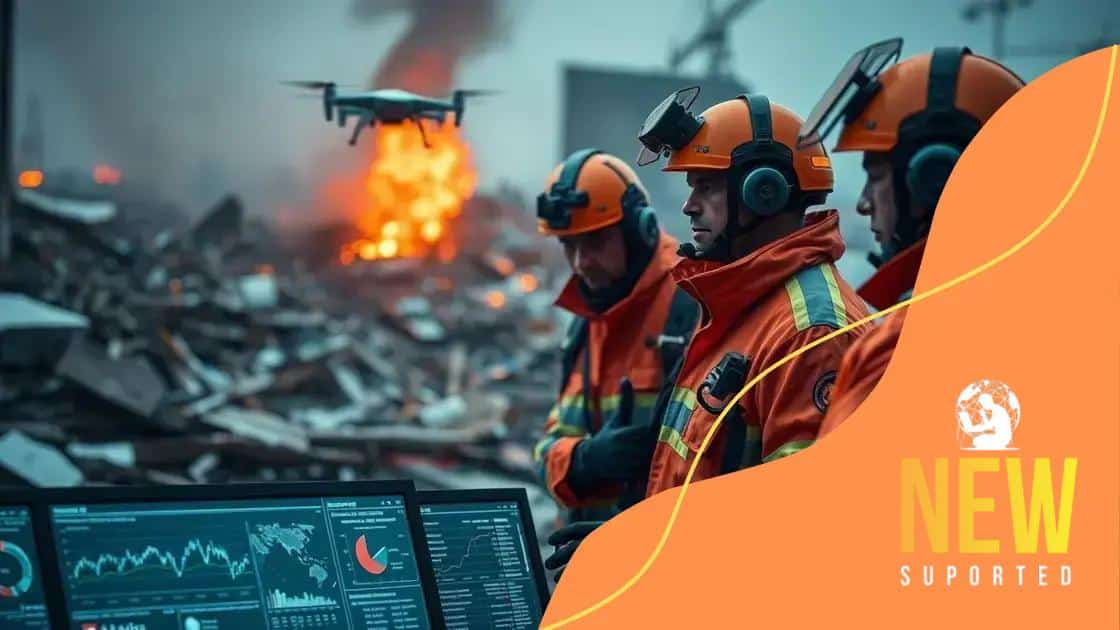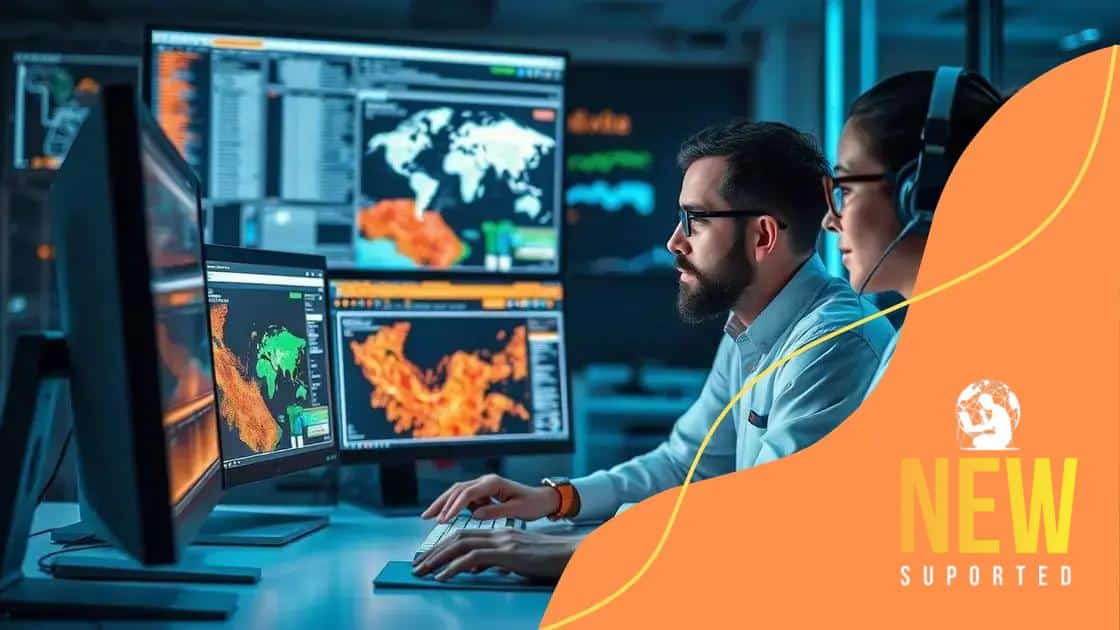How AI is improving disaster response capabilities

AI is improving disaster response capabilities by utilizing real-time data analytics, predictive modeling, and IoT integration, enhancing efficiency and coordination among emergency responders to save lives and manage resources during crises.
How AI is improving disaster response capabilities has become a hot topic in today’s emergency management landscape. Have you ever wondered how technology can save lives during crises? Let’s dive in!
Understanding AI’s role in disaster response
Understanding how AI plays a role in disaster response is crucial. By leveraging technology, response teams can act faster and more efficiently in times of crisis. Let’s explore the impact of AI on disaster situations.
Real-time Data Collection
AI helps gather data from various sources, including social media, sensors, and satellite images. This information enables teams to assess the situation rapidly.
- Immediate insights into disaster areas
- Better communication among agencies
- Faster decision-making processes
Enhanced Predictive Analytics
Through advanced algorithms, AI analyzes patterns from past disasters. This predictive capability allows responders to prepare for potential future events. With AI, teams can anticipate needs and allocate resources more effectively.
For example, understanding weather patterns can alert teams about impending floods or storms. This way, human lives can be prioritized, and evacuations can occur before the worst impacts.
Improving Resource Allocation
AI also plays a significant role in optimizing resource distribution during emergencies. By analyzing real-time data, AI determines the best way to allocate supplies and personnel.
- Efficient use of ambulances and rescue teams
- Reduced waste of resources
- Improved logistics for delivering aid
As a result, communities can recover more quickly and return to normalcy after a disaster strikes.
In summary, understanding AI’s role in disaster response provides critical insights into how technology can save lives and mitigate damages in emergencies. This intersection of technology and humanitarian efforts illustrates the profound benefits of AI in our world today.
Real-time data collection and analysis
Real-time data collection and analysis are vital in enhancing disaster response. This approach allows emergency teams to react swiftly to changing situations and make informed decisions. Using various technologies, responders gather immediate data from different sources.
Sensors and Drones
Sensors and drones play a key role in collecting data during disasters. These tools help assess the affected areas more effectively. Drones, for instance, can capture aerial images of disaster zones, providing valuable insights on damage and debris.
- Real-time aerial footage
- Data on environmental conditions
- Mapping of affected areas
Social Media Monitoring
Social media platforms also serve as powerful tools for real-time data collection. By tracking posts and updates, emergency teams can gather information from citizens in affected areas.
This helps in prioritizing rescue efforts based on where people need help the most. Responders can identify trends and allocate resources as necessary. Timely analysis ensures that help reaches those in need without delay.
Data Integration for Decision-Making
Data integration is crucial for effective disaster management. By combining various data sources, teams gain a comprehensive view of the situation. This integration helps in decision-making in real-time, allowing for effective communication between different agencies.
- Streamlined information flow
- Improved collaboration among responders
- Better resource management
With thorough data analysis, teams can adjust their strategies to meet the dynamic demands of a disaster. Thus, the effectiveness of response operations significantly improves, ensuring quicker recovery for affected communities.
Predictive modeling for crisis management

Predictive modeling for crisis management is an essential tool in enhancing disaster response. This technique uses data to forecast possible scenarios, helping teams prepare for what might happen in a crisis.
Understanding Predictive Models
At its core, predictive modeling involves analyzing historical data to identify patterns. By examining past disasters, teams can create models that simulate future events. This allows responders to anticipate challenges and responses needed.
- Identifying vulnerabilities in regions
- Forecasting resource needs
- Simulating various disaster scenarios
Applications in Disaster Response
In disaster response, these models serve multiple purposes. For instance, they can predict the impact of a hurricane on a coastal city. By forecasting the storm’s path and strength, responders can efficiently plan evacuations and distribute resources.
Additionally, modeling helps assess community resilience, indicating how well a region can recover from disasters. With this information, organizations can better prepare and support their communities.
Benefits of Predictive Modeling
Using predictive modeling provides significant advantages. It enables teams to focus their efforts where they are most needed. Effective planning can result in:
- Reduced response time during emergencies
- Improved safety for residents and responders
- Optimal allocation of resources
This proactive approach makes a difference when time is critical. As technology evolves, so do these models, continually improving their accuracy and applicability in real-world situations.
Case studies of AI in action during disasters
Case studies of AI in action during disasters showcase its transformative impact on emergency response. These real-world examples illustrate how technology can enhance efforts in various crisis situations.
Hurricane Harvey
During Hurricane Harvey in 2017, AI played a crucial role in analyzing massive amounts of data. By utilizing machine learning algorithms, emergency teams were able to predict flood zones effectively. This lead to better evacuation plans and resource allocation. The use of AI supported real-time updates, ensuring that residents received vital information promptly.
- Improved prediction of flooding areas
- Enhanced communication with the public
- Efficient deployment of rescue teams
California Wildfires
In 2020, AI systems were implemented to monitor wildfire behaviors in California. Drones equipped with AI technology tracked changes in fire patterns, helping firefighters respond quickly to new flare-ups. This timely information significantly reduced property damage and preserved lives.
The integration of AI and satellite imagery allowed for continuous assessment of the fire’s progression. Teams could then use this data to strategize their firefighting efforts more effectively.
Earthquakes in Japan
Japan utilized AI to enhance earthquake preparedness and response. The country developed systems that analyzed seismic data in real-time. These systems enabled rapid alerts, giving people crucial seconds to seek safety before shaking began.
- Faster emergency response
- Improved evacuation strategies
- Life-saving impact on communities
These case studies highlight the ability of AI to adapt and improve disaster response, showing that technology can make a significant difference in saving lives and protecting communities.
Future trends in AI for disaster response
Future trends in AI for disaster response indicate significant advancements that will revolutionize how we manage crises. As technology evolves, AI continues to become more integral in enhancing emergency response systems.
Advanced Predictive Analytics
One trend is the use of advanced predictive analytics. These systems will analyze vast amounts of data more efficiently. By leveraging historical and real-time data, AI can offer even more accurate predictions during disasters. This foresight allows teams to prepare better and allocate resources more effectively.
- Real-time modeling of potential crisis scenarios
- Improved forecasting for natural disasters
- Increased efficiency in resource management
Integration of IoT Devices
Another exciting development is the integration of Internet of Things (IoT) devices. These smart devices can collect and transmit data in real time. They help track environmental changes and gather information from disaster sites.
For example, sensors can monitor water levels in rivers to predict floods. This data feeds into AI systems, allowing for quicker and more informed decisions.
Enhanced Communication Systems
Future AI systems will also focus on improving communication among agencies. Better collaboration through AI-driven platforms ensures that responders share information effectively. This seamless communication is essential in chaotic situations.
- Faster information sharing
- Improved coordination of rescue efforts
- Enhanced public alerts during emergencies
As we move forward, AI technologies are expected to become even more sophisticated. Their ability to analyze data, predict outcomes, and optimize responses will undoubtedly save more lives during disasters, making them invaluable assets in emergency management.
FAQ – Frequently Asked Questions about AI in Disaster Response
How can AI improve disaster response times?
AI can analyze real-time data rapidly, enabling quicker decision-making and response strategies during emergencies.
What role do predictive analytics play in disaster management?
Predictive analytics help forecast potential disaster scenarios, allowing teams to prepare effectively and allocate resources efficiently.
How do IoT devices contribute to disaster response efforts?
IoT devices collect and transmit real-time data from disaster sites, helping teams monitor conditions and react swiftly to changes.
What are some future trends in AI for disaster response?
Future trends include enhanced predictive analytics, improved communication systems among agencies, and the integration of more IoT devices.






